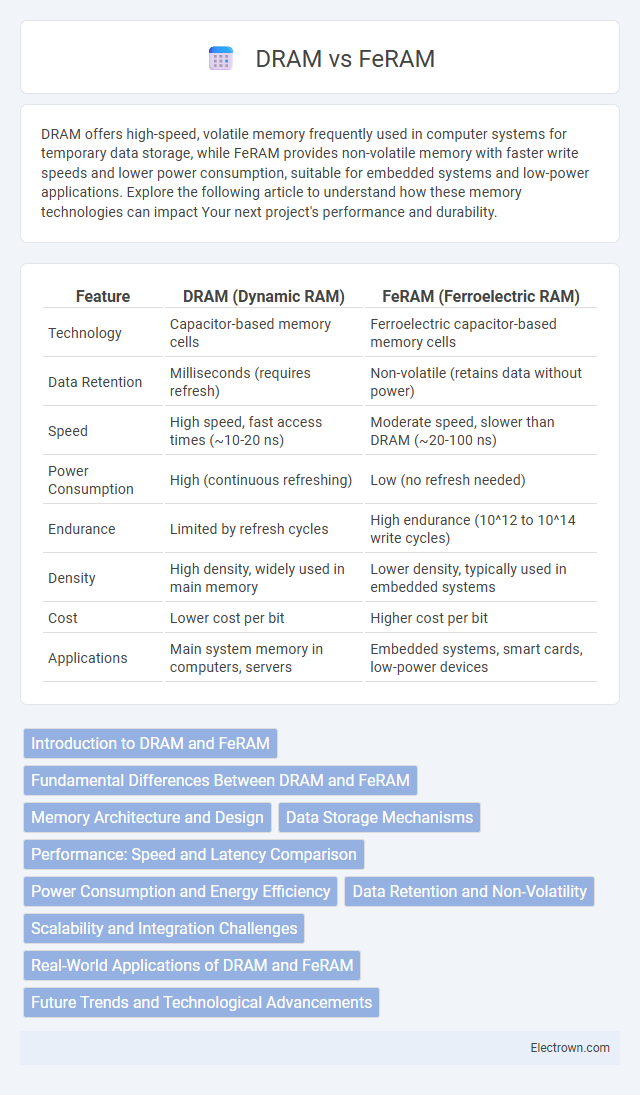DRAM offers high-speed, volatile memory frequently used in computer systems for temporary data storage, while FeRAM provides non-volatile memory with faster write speeds and lower power consumption, suitable for embedded systems and low-power applications. Explore the following article to understand how these memory technologies can impact Your next project's performance and durability.
Table of Comparison
| Feature | DRAM (Dynamic RAM) | FeRAM (Ferroelectric RAM) |
|---|---|---|
| Technology | Capacitor-based memory cells | Ferroelectric capacitor-based memory cells |
| Data Retention | Milliseconds (requires refresh) | Non-volatile (retains data without power) |
| Speed | High speed, fast access times (~10-20 ns) | Moderate speed, slower than DRAM (~20-100 ns) |
| Power Consumption | High (continuous refreshing) | Low (no refresh needed) |
| Endurance | Limited by refresh cycles | High endurance (10^12 to 10^14 write cycles) |
| Density | High density, widely used in main memory | Lower density, typically used in embedded systems |
| Cost | Lower cost per bit | Higher cost per bit |
| Applications | Main system memory in computers, servers | Embedded systems, smart cards, low-power devices |
Introduction to DRAM and FeRAM
DRAM (Dynamic Random-Access Memory) is a widely used volatile memory technology characterized by high density and fast access times, relying on capacitors to store bits that require frequent refreshing. FeRAM (Ferroelectric Random-Access Memory) is a non-volatile memory type utilizing ferroelectric capacitors to retain data without power, offering lower power consumption and faster write speeds compared to traditional Flash memory. While DRAM excels in speed and scale for temporary data storage, FeRAM provides advantages in energy efficiency and data retention for specific embedded applications.
Fundamental Differences Between DRAM and FeRAM
DRAM (Dynamic Random-Access Memory) stores data as electrical charges in capacitors, requiring constant refreshing to maintain information, while FeRAM (Ferroelectric RAM) uses ferroelectric materials to retain data through spontaneous polarization, enabling non-volatile memory storage without power. DRAM offers higher density and faster access speeds but consumes more power due to refresh cycles, whereas FeRAM provides lower power consumption and faster write speeds with limited scalability. These fundamental differences impact their use in applications demanding volatility, speed, endurance, and power efficiency.
Memory Architecture and Design
DRAM (Dynamic Random-Access Memory) employs a capacitor-based design where each bit requires a capacitor and a transistor, necessitating periodic refresh cycles due to charge leakage. FeRAM (Ferroelectric RAM) utilizes a ferroelectric layer to retain data through polarization states, enabling non-volatile memory with faster write speeds and lower power consumption. Your choice between DRAM and FeRAM should consider these architectural differences impacting speed, endurance, and data retention requirements.
Data Storage Mechanisms
DRAM stores data using capacitors that hold electric charges, requiring constant refreshing to maintain information, while FeRAM uses ferroelectric materials to retain polarization states, enabling non-volatile data storage without power. FeRAM's ferroelectric layer switches polarization direction to represent binary data, offering faster write speeds and lower power consumption than DRAM's charge-based storage. Your choice impacts energy efficiency and data retention, with FeRAM providing persistent memory and DRAM delivering high-speed volatile storage.
Performance: Speed and Latency Comparison
DRAM (Dynamic Random-Access Memory) offers high-speed data access with latencies typically around 10-20 nanoseconds, making it suitable for applications requiring rapid memory refresh and fast data retrieval. FeRAM (Ferroelectric RAM), although providing non-volatile memory benefits, generally exhibits slightly higher latency, ranging from 20 to 100 nanoseconds, due to its ferroelectric layer switching mechanism. Despite FeRAM's slower write speeds compared to DRAM, its low power consumption and endurance make it a competitive alternative for specialized memory applications where data persistence and reliability are critical.
Power Consumption and Energy Efficiency
FeRAM offers significantly lower power consumption compared to DRAM due to its non-volatile nature, as it retains data without continuous power supply, leading to enhanced energy efficiency in standby modes. DRAM requires constant refreshing to maintain data, resulting in higher energy usage and increased heat generation. Consequently, FeRAM is preferred in applications where minimizing energy consumption and improving battery life are critical.
Data Retention and Non-Volatility
FeRAM offers superior data retention and non-volatility compared to DRAM, maintaining stored information without power due to its ferroelectric layer, making it ideal for applications requiring persistent memory. DRAM relies on capacitors that must be constantly refreshed to retain data, leading to volatility and potential data loss during power interruptions. Your choice between these memory types should consider FeRAM for long-term data storage solutions and DRAM for high-speed, volatile memory needs.
Scalability and Integration Challenges
DRAM faces significant scalability challenges due to its reliance on capacitors that shrink in size, leading to leakage currents and reduced reliability as technology nodes advance. FeRAM offers better scalability prospects because its ferroelectric layer enables non-volatile data storage without charge leakage, but integrating ferroelectric materials with standard CMOS processes poses complex manufacturing challenges. Both technologies require innovative material and process solutions to address integration hurdles and maintain performance at nanoscale dimensions.
Real-World Applications of DRAM and FeRAM
DRAM is widely used in high-performance computing environments, such as servers, desktop computers, and smartphones, due to its fast access speeds and high-density storage capabilities. FeRAM finds practical applications in low-power and non-volatile memory requirements, including smart cards, RFID systems, and industrial sensors, where data retention without constant power is critical. Emerging IoT devices leverage FeRAM's endurance and energy efficiency, while DRAM continues to dominate in applications demanding rapid volatile memory access.
Future Trends and Technological Advancements
Future trends in DRAM technology emphasize increasing density and speed through advanced lithography and 3D stacking, aiming to meet the growing demands of AI and high-performance computing. FeRAM advancements focus on enhancing energy efficiency, non-volatility, and endurance by leveraging novel ferroelectric materials and integrating with CMOS processes for instant, low-power memory solutions. Your choice between DRAM and FeRAM will depend on the need for ultra-fast volatile memory or energy-efficient, persistent storage in emerging applications.
DRAM vs FeRAM Infographic

 electrown.com
electrown.com